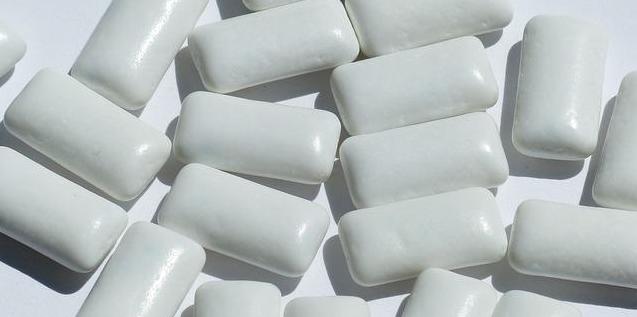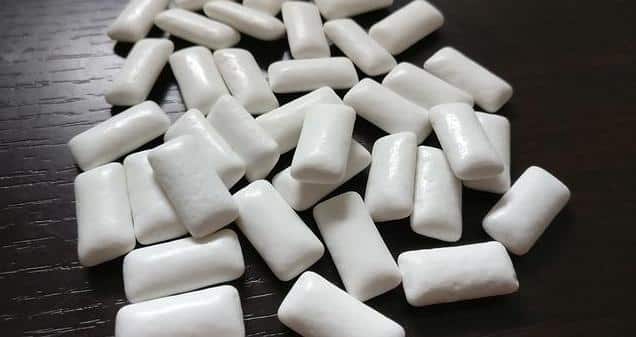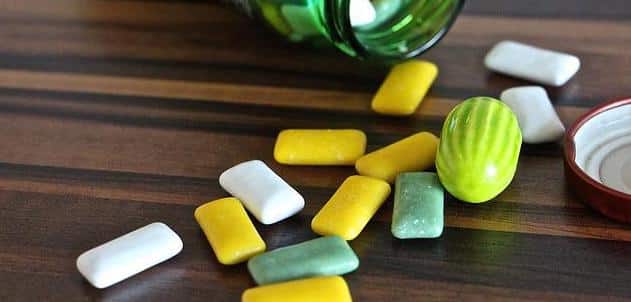In late 2021 I began experiencing persistent “globus sensation” accompanied by a “burning sensation” in the back of my throat.
An urgent care doctor diagnosed sinusitis but suspected that acid reflux could be the cause – and thus referred me to an ENT who diagnosed GERD/LPR.
Prior to my diagnosis, I searched for natural things that might help reduce acid reflux and something simple that was recommended was chewing gum.
Initially I didn’t know that mint gum could worsen reflux – and I chewed some mint gum that I had around the house.
Later I ordered Alka Seltzer gum specially formulated with calcium carbonate (750 mg) to help treat reflux – but this failed to reduce my symptoms and seemingly correlated with symptom exacerbations.

Perhaps the exacerbations were not directly from the gum – as I: (1) hadn’t yet modified my diet/lifestyle to reduce reflux; (2) hadn’t used proven reflux therapies (e.g. H2 blockers/PPIs); and (3) was testing “natural supplements” that seemingly worsened reflux symptoms.
After making lifestyle/diet modifications, utilizing appropriate anti-reflux therapies, and avoiding a barrage of BS “natural supplements” (recommended by Redditors) – I reinstated chewing completely plain gum after meals for my reflux.
Results? Modest benefit – no worsening of symptoms.
Chewing Gum & Acid Reflux (Research)
I did a literature search for studies/papers that evaluated or discussed the effects of chewing gum on acid reflux. Included below are summaries of those studies.

Study #1: Effect of GutsyGum™, A Novel Gum, on Subjective Ratings of Gastroesophageal Reflux (R)
Brown et al. (2015): GutsyGum™ is more effective than a placebo in alleviating primary symptoms of heartburn and acid reflux.
- GutsyGum ingredients: calcium carbonate + proprietary blend (licorice extract, papain, apple cider vinegar)
- Effectiveness of GutsyGum was compared to that of a placebo gum after a refluxogenic meal.
- 24 individuals with gastroesophageal reflux (GER) participated in a double-blind, placebo-controlled, crossover trial with a 1-week washout phase between treatments.
- Measures: GER symptom questionnaires (10 cm Visual Analog Scales) – (1) immediately following the meal AND (2) at regular intervals up to 4 hours post-meal.
- Results? Mean acid reflux score was significantly lower after GutsyGum (~0.72) than the placebo gum (1.46). There were no differences in secondary outcomes – but there was a trend towards reduced reflux-related pain.
Limitations…
- No reflux post-meal (?): Several individuals did NOT develop symptoms in response to the refluxogenic meal and amongst those who did, most were not severe. Given the small sample, this may have affected outcomes.
- Small sample: 24 participants with gastroesophageal reflux – but not necessarily “GERD.” (Some didn’t even experience reflux after the meal.)
- No comparison with other antacid-infused gum: unclear as to whether ingredients beyond calcium carbonate actually help.
- No objective acid reflux measurements: Via ambulatory pH monitoring.
- Placebo gum: Specific “placebo gum” ingredients not reported (could’ve been “mint” for all we know – which would worsen reflux).
- Financial compensation: 2 of the authors (Tim Green & Simon Wood) were paid in consulting fees by Gutsy Gum LLC. Consulting fees don’t inherently mean anything is wrong with the study – but that its limitations should be meticulously examined.
At this time, we should NOT assume that GutsyGum is superior in efficacy to other antacid-infused gums (particularly those containing an equal dose of calcium carbonate).
Furthermore, the inclusion of apple cider vinegar (ACV) makes no sense other than for marketing potential given that ACV is acidic.
In theory, the presence of ACV might worsen reflux or make this gum less effective than other antacid-infused gums for reflux. (Reviews on Amazon for this brand of gum suggest that it may not work as well as the above study suggests.)
Study #2: The Effect of Chewing Sugar-Free Gum on Gastro-Esophageal Reflux (R)
Moazzez et al. (2005): “Chewing sugar-free gum for half an hour after a meal can reduce acidic postprandial esophageal reflux.”
- Chewing gum was thought to increase swallowing frequency whereby it would improve clearance rate of reflux within the esophagus.
- The null hypothesis of this study was that chewing gum has zero effect on the clearance of reflux from the distal esophagus.
- 31 subjects with reflux symptoms were given a refluxogenic meal (2 bars full-fat cheddar cheese, green salad with 2 tablespoons of mayo, 15 large chips, ½ pint of full-fat milk) twice and were selected to chew gum for 30 minutes after eating.
- All patients were requested to stop PPIs, H2 blockers, and prokinetic agents for 48 hours prior to the study.
- Esophageal pH was measured and pH data were analyzed and compared during postprandial periods (after eating) for 2 hours for 2 meals.
- The median % times pH < 4 (acidic): (1) with gum ~3.6 (0.3-7.3) vs. (2) without gum ~5.7 (1.7-13.5).
Specific gums used: Orbit chewing gum, Wrigley’s chewing gum.
What can we learn here? Chewing sugar-free gum after meals significantly reduced the amount of time esophageal pH was below 4 (indicative of acidity) relative to not chewing gum.
Study #3: Clinical Effectiveness of a New Antacid Chewing Gum on Heartburn & Esophageal pH Control (R)
Collings et al. (2002): Calcium carbonate gum effectively neutralizes esophageal acidity and relieves symptoms after a meal, and is better than chewable antacids in duration of heartburn relief.
- Researchers investigated the effect of a gum that releases antacid as it is chewed on acid neutralization capacity and heartburn relief.
- 24 subjects participated in a crossover study with 4 regimens: placebo; chewable antacid tablets (1000 mg CaCO3), low-dose gum (600 mg CaCO3), and high-dose gum (900 mg CaCO3).
- Dual pH probes were utilized to determine acidity and reflux events. Visual analog and Likert scales were also used to measure symptoms.
- Results: Both low-dose antacid gum (600 mg calcium carbonate) and high-dose antacid gum (900 mg calcium carbonate) decreased heartburn compared to a placebo for 120 minutes. Chewable antacids and gums immediately increased esophageal pH – with significant improvement 15-30 minutes post-dose. High-dose gum decreased heartburn more than chewable antacids up to 120 minutes post-dose.
What can we learn here?
Antacid-infused chewing gum AND chewable antacids both significantly increase esophageal pH post-administration (with notable improvements observed ~15-30 minutes after).
Chewing gum infused with calcium carbonate (600 mg & 900 mg) provided faster and longer-term reflux/heartburn relief than chewable antacids.
Chewing gum infused with higher-dose calcium carbonate (900 mg) was significantly more effective for reducing heartburn than chewable antacids (up to 120 min post-dose).
The most effective intervention in this study was higher-dose antacid-infused gum (900 mg CaCO3).
I would’ve liked a comparison with other groups: (1) regular gum AND (2) antacid + regular gum.
Why? To determine whether most of the therapeutic benefit is derived from: (A) chewing gum OR (B) chewing gum with antacids (e.g. antacids delivered more effectively to the esophagus, linger for longer duration in the esophagus, and/or coat the esophageal tissue better than standard antacids).
Also possible is that a slower, sustained release of antacids via gum provides a longer lasting antacid effect than would taking chewable antacids.
Study #4: Effects of Gum Chewing on Pharyngeal & Esophageal pH (R)
Smoak & Koufman (2001): “Data show that gum chewing consistently increases esophageal and pharyngeal pH, and that bicarbonate gum causes greater increase than regular gum. For patients with LPR, gum chewing appears to be a useful adjunctive antireflux therapy.”
- 40 consecutive, unselected, adult patients undergoing ambulatory double-probe (simultaneous pharyngeal & esophageal) pH monitoring for diagnosis of LPR served as the subjects.
- Subjects were asked to chew 2 sticks of gum 4 times during pH studies.
- 20 subjects chewed sugarless gum & 20 subjects chewed sugarless gum containing bicarbonate. 10 subjects with clinical LPR were used as controls.
- Subjects recorded the beginning and end of each gum-chewing period.
- Mean pH values for gum-chewing intervals and comparable pre-gum chewing intervals were analyzed statistically for pharyngeal & esophageal probe data.
- Gum-chewing pH data were compared to controls.
What were the results?
37/40 subjects (92%) the mean esophageal/pharyngeal pH increased with gum chewing.
- Regular gum: Mean increases in pharyngeal pH (6.85 to 7.30) & esophageal pH (6.45 to 7.14)
- Bicarbonate gum: Mean increases in pharyngeal pH (6.70 to 7.43) & esophageal pH (6.44 to 7.49)
In some individuals, chewing gum completely abolished reflux events.
The average time of gum-chewing episodes was ~25.2 minutes (+/- 16 minutes) and the mean buffering effect of bicarbonate gum chewing was ~49.1 minutes (+/- 23.6 minutes).
The beneficial effect of gum chewing on pH was maintained 2.4 times (+/- 1.3 times) as long as the gum-chewing period – and in no case did reflux occur during gum chewing.
In controls, the mean buffering effect of meals (time from end of meal to first reflux episode) was ~27.4 minutes (+/- 18.2 minutes).
Authors stated that gum chewing may also increase swallowing rates and peristalsis (a series of contractions that propel food through the digestive tract) – but this hypothesis hasn’t been studied. (Patients with GERD tend to have lower amplitude of esophageal peristalsis).
Specific gums used
Regular gum: Wrigley’s Winterfresh Sugarfree Gum (2 sticks at a time)

Bicarbonate gum: Arm & Hammer Sugarfree Baking Soda Gum
Researcher recommendations:
“We currently recommend that patients with postcibal (i.e. post-meal) symptoms chew 2 pieces of bicarbonate gum one half-hour after a meal or at the time of onset of symptoms – whichever comes first.
In addition, we recommend gum chewing for LPR patients at certain other times, depending on symptom patterns (e.g. before or after exercise, before going to bed, etc.).”
What can we learn here? Chewing sugar-free gum after meals significantly increases esophageal/laryngeal pH (reduces acidity) in patients with laryngopharyngeal reflux (LPR) – and this beneficial effect is enhanced if the sugar-free gum contains bicarbonate.
Study #5: Walking & Chewing Reduce Postprandial Acid Reflux (R)
Avidan et al. (2001): “Chewing gum after a meal helps to reduce postprandial esophageal acid exposure.”
- Researchers investigated whether walking or gum chewing affected meal-induced gastroesophageal reflux in 12 subjects with GERD and 24 healthy controls.
- All subjects were examined with pH-metry for 5 hours on 3 separate days.
- After baseline recording of pH for 1 hour, all subjects were fed a standard breakfast (fried eggs, bacon, toast, coffee) during a 20-minute period.
- Esophageal pH was measured after the 20-minute eating period: (1) while sitting for an additional 4 hours (one of the days) or (2) while walking for 1 hour then sitting for the next 3 hours (another day).
What were the results?
Food intake caused gastroesophageal reflux in those with GERD and in healthy controls – but postprandial reflux was more pronounced in GERD patients than controls.
Chewing gum for ~1 hour after the meal reduced acid contact time in both groups – with a more pronounced effect in the GERD patients than controls.
The beneficial effect of chewing gum lasted ~3 hours in both groups (GERD patients & healthy controls).
The beneficial effect of a 1-hour walk post-meal was: (A) only observed in reflux patients; (B) of modest/mild magnitude; and (C) was short-lasting.
What can we learn here? Chewing gum after meals seems to significantly decrease acid contact time in patients with reflux (e.g. GERD) and in healthy individuals. Walking after a meal seems to provide modest short-duration benefit in reflux patients only.
Study #6: Esophageal Acid & Salivary Secretion: Is Chewing Gum a Treatment Option for Gastroesophageal Reflux? (R)
von Schonfeld et al. (1997): “Our study [also] suggests that chewing gum might be a non-pharmacological treatment option for some patients with symptomatic gastroesophageal reflux.”
- A study was designed to investigate the relationship between esophageal acid and (A) rested and (B) stimulated – salivary secretion.
- 10 healthy volunteers participated in the study and acid clearance times after a bolus infusion of 20 mL 0.1 N hydrochloric acid were measured with ambulatory esophageal pH monitoring.
- With constant swallowing rate and resting salivary flow – acid clearance times were significantly longer with dry (as opposed to “wet”) swallows (~12.6 min vs. ~6.9 min).
- Chewing a gum base doubled salivary flow (~26 mL/15 min vs. ~13.2 mL/15 min) and acid clearance time was significantly shortened (~6.9 min vs. ~2.3 min).
- Compared to water control: salivary flow, pH, and protein content were not affected by a bolus infusion of hydrochloric acid – and this held true for resting and gum-stimulated salivary secretion.
- The findings indicate that an esophageal-salivary reflex becomes effective only in prolonged episodes of gastroesophageal reflux.
What can we learn here? Chewing gum doubles salivary flow rate and this likely helps reduce acid clearance times. Though this was a small study with healthy individuals (as opposed to those with clinical reflux conditions e.g. GERD) – it supports the idea that gum chewing could reduce postprandial reflux severity/duration.
Other reports & insights… re: Gum & Reflux
Durazzo et al. (2020)
Sugar-free chewing gum is recommended as a strategy to stop the progression of dental erosion associated with extra-esophageal GERD because of its ability to stimulate salivary flow. (R)
Ballal et al. (2016)
“Chewing sodium bicarbonate gum for 10 minutes was found to raise the interproximal plaque pH from 4.3 following an acidogenic challenge (toffee chewing) to a pH of 6.1. Chewing bicarbonate gum would, thus, be expected to increase salivary pH as bicarbonate ions leach out from the gum.” (R)
da Silva et al. (2015)
“Gum chewing causes an increase in saliva swallowing in both patients with excessive belching and controls, and an increase in air swallowing in patients with excessive belching 20 minutes after yogurt ingestion. Gum chewing did not increase or decrease the frequency of gastric/supragastric belches.” (R)
Dundar & Sengun (2014)
“Patients with GERD are frequently dehydrated and have reduced salivary flow rates. To improve salivary flow rates, patients suffering from erosion should be advised to use sugar-free antacids and xylitol chewing gums.” (R)
Poulton (2012)
“We find no evidence that gum chewing during pre-anesthetic fasting increases the volume or acidity of gastric juice. On the contrary, there is evidence that gum chewing promotes gastrointestinal motility and physiologic gastric emptying.” (R)
Park & Chang (2012)
“Chewing sugarless or bicarbonate gum may decrease reflux.” (R)
Sakamoto (2011)
A study with 10 healthy male volunteers reported “chewing gum had no effect on rate of gastric emptying.” It was suggested that chewing gum may reduce gastrointestinal symptoms through other mechanisms such as saliva and the autonomic nervous system (ANS). (Keep in mind that results may have differed in non-healthy patients with GI disorders). (R)
Bujanda et al. (2007)
Gum chewing after eating along with standing up and going to bed 4 hours after dinner improves symptoms of reflux and GERD. (R)
Sarosiek et al. (1996)
In patients with reflux esophagitis, masticatory stimulation (with a tasteless parafilm) caused increases in: salivary volume by 205%; pH by 7.6%; bicarbonate by 335%; mucin by 137%; protein by 98%; epidermal growth factor by 123%; prostaglandin E2 by 132%; transforming growth factor alpha by 80%. (R)
(Though this isn’t “gum chewing” – it is reasonable to hypothesize that similar or better effects would be achieved with gum chewing.)
Main takeaways from the research of gum chewing on acid reflux…

Nearly all studies are unanimous in suggesting that chewing sugar-free gum seems to reduce the severity and duration of postprandial reflux (and associated symptoms like heartburn).
The acid reducing effect seems to be enhanced when the sugar-free gum contains antacid/alkaline components (e.g. bicarbonate) – and further enhanced if the infused antacid dose is higher than lower (900 mg calcium carbonate provided greater relief than 600 mg).
I found one study by Helman (1988) that found chewing 7 pieces of gum stimulated acid output to a similar degree as consuming a cheeseburger in 12 patients with duodenal ulcer disease. (R)
That said, there’s no evidence from the Helman study to suggest that chewing gum increased acid reflux severity/episodes.
Furthermore, the specific type of chewing gum and its ingredients may have mattered a lot (and I cannot access the full-text to determine whether these were mentioned).
Most studies examining the effect of chewing gum on acid reflux severity/duration are limited by small sample sizes – but many are enhanced by esophageal pH monitoring (which objectively monitors pH and reflux events).
Overall, it seems as though chewing sugar-free antacid-infused gum postprandially (after meals) is a cheap, non-pharmacological, low-risk, adjunct intervention for episodic reflux – and reflux diseases (e.g. GERD & LPR).
How chewing gum might help reflux (mechanisms)
There are a variety of mechanisms by which chewing gum postprandially (after meals) could help reduce the severity, frequency, and acidity of reflux episodes.

Chewing gum is a well-known salivary stimulant that increases: salivary flow rate; bicarbonate levels in saliva; and buffering capacity.
It may also induce increased swallowing frequency – which would expedite the clearance rate of refluxate from within the esophagus.
Increased salivary secretion & flow rate
The primary means by which chewing gum can help some cases of reflux is by significantly increasing salivary secretion and flow rate. Increased salivary flow rate helps promote the clearance of refluxate (i.e. refluxed material) throughout the esophagus. (R)
Increased salivary bicarbonate (higher pH)
Chewing gum likely stimulates the production of salivary bicarbonate such that esophageal pH becomes more alkaline and less acidic.
In other words, chewing plain gum (even without the infusion of antacids) makes saliva more alkaline and helps neutralize acids that were refluxed.
Enhanced buffering capacity
Patients with reflux conditions (e.g. GERD) tend to have “low” or “very low” salivary buffering capacity. (R)
There are 3 buffer systems in saliva: protein buffer, phosphate buffer, and carbonic acid/bicarbonate buffer.
Chewing gum enhances overall salivary buffering capacity – which might help protect teeth, the laryngopharynx, and esophagus from acid-induced damage.
Increased swallowing frequency
Chewing gum may increase swallowing frequency as a result of increased saliva secretion/flow rate such as to expedite the clearance of any refluxate within the esophagus.
A study by Schonfeld et al. (1997) found that chewing gum significantly enhanced esophageal clearance rate in 10 healthy volunteers.
Peristalsis induction
Chewing gum may induce peristalsis or involuntary contractions that create wave-like movements to propel material through the gastrointestinal tract.
If this is the case, it could hasten the rate of esophageal clearance and possibly bowel movements – both of which might decrease reflux.
Antacid components (alkalinity)
Although even unflavored/plain gum can be beneficial for reflux, some gums (specifically designed for reflux) are infused with antacids:
- Sodium bicarbonate
- Calcium carbonate
- Magnesium carbonate
This may seem similar to popping an antacid (e.g. TUMS) after eating, however, gum infused with antacids may deliver the antacids in a superior manner such that they more effectively coat the esophageal tissue by mixing with saliva before swallowed.
Many conventional antacids are chewed and swallowed with water which may prevent various components from “coating” the esophagus as well as those ingested in chewing gum format.
Autonomic nervous system (ANS) modulation
Some researchers believe that the act of chewing gum may modulate the autonomic nervous system (ANS) in specific ways (e.g. stimulation of vagus nerve) which could alter esophageal sphincter function, gastrointestinal function, and/or gastric acid secretion – to reduce the frequency/severity of reflux. (R1, R2)
Laryngopharyngeal reflux (LPR) & Chewing Gum
Smoak & Koufman (2001) suggest that chewing gum may be particularly beneficial in the adjunct treatment of laryngopharyngeal reflux (LPR).

Unlike the esophagus which secretes bicarbonate, laryngopharyngeal mucosa lacks intrinsic protection against the effect of reflux. The larynx also lacks significant extrinsic protection.
Throughout the esophagus, peristalsis and salivary bicarbonate promote restoration of a neutral pH following a reflux episode – whereas the laryngopharynx lacks innate mechanisms of acid clearance.
Chewing gum has been shown to: (1) enhance salivary flow rate; (2) increase salivary bicarbonate levels; and (3) increase swallowing frequency – all of which could reduce the frequency/severity of LPR symptoms in the esophagus and pharynx.
How chewing gum could worsen reflux (Hypothetical mechanisms)
There is no significant evidence to support the idea that chewing gum (of any kind) worsens reflux.
However, it is thought that gums with: acidic, citrus, minty, and/or sugary components have potential to significantly worsen preexisting reflux symptoms (for obvious reasons).
Acidic ingredients
Acidify the stomach and gastrointestinal tract.
Any ingredient with the term “acid” should be considered a red flag. (Though small amounts of certain “acids” may be fine in some cases due to the extremely small quantity used).
Individuals with LPR should be particularly cautious as any acids could activate pepsinogens in the larynx (causing throat burn).
Citrus components
Many gums contain citrus components (e.g. citric acid) such as to enhance flavor or provide specific fruit flavors.
The problem with citrus components is that they aggravate reflux due to their acidity. (These are an acidic ingredient but many don’t realize it.)
If there’s a considerable amount of citrus within your gum – it might make your reflux worse than avoiding gum chewing.
Mint components
Many individuals report that mint flavors elicit a “soothing sensation” within the esophagus to offset heartburn.
However, mint flavors are problematic for reflux because they cause transient relaxation of the lower esophageal sphincter (LES) – which increases the total number of reflux episodes.
- Mint
- Peppermint
- Spearmint
Any gum with “mint” listed as an ingredient or flavor should probably be avoided.
Perhaps an artificial “mint flavor” with non-mint components might be okay – but it’s possible that a similar effect of transient lower esophageal sphincter relaxation could be induced by the artificial ingredients.
Anecdote (Mint gum)
Years ago I experienced serious heartburn.
Always enjoyed chewing mint gum and as the symptoms worsened – I chewed more gum.
I thought the gum chewing was helping the problem. When I saw the doctor I was surprised to learn that the mint was making things worse.
I went “cold turkey” off mint and my symptoms completely disappeared in less than 2 months.
Sugar & fructose
Sugar and fructose can damage teeth (e.g. enamel erosion) and accelerate cause cavity formation via altering oral bacteria.
Additionally, sugar intake has been associated with worsening of reflux – and many report a worsening of reflux following fructose ingestion.
Thankfully most gums don’t contain sugar or fructose – and instead use healthier substitutes.
Aerophagia & belching (?)
Chewing gum can cause some individuals to swallow a lot of air.
Swallowing a considerable amount of air (aerophagia) may result in frequent belching and belching may be associated with a gaseous reflux (reflux of acidic components via gases involved in the belch).
Variables that determine whether chewing gum helps reflux
Included below are some variables that may influence how chewing gum affects reflux conditions (e.g. acid reflux, GERD, LPR, etc.).

Specific gum
Certain gums that contain acidic ingredients, citrus ingredients, and/or mint ingredients/flavors (e.g. peppermint, spearmint, etc.) may aggravate/worsen preexisting reflux.
- Sugar-free & fructose-free (?): Tends to be ideal for reflux – sugar/fructose may worsen reflux and can damage teeth.
- Flavors: Certain flavors such as mint/citrus may cause transient relaxation of the LES which could worsen reflux. Unflavored gum or neutrally-flavored gum should be least problematic for those with reflux. Karami-Nogourani et al. (2011) found that specific gum flavors can have unique effects on salivary flow rate. (R)
- Antacid component (?): Addition of antacids to gum (e.g. calcium carbonate, sodium bicarbonate, magnesium carbonate) tends to bolster the therapeutic effect of gum in the management of reflux.
Gum amount (density & thickness)
The amount of gum that you chew could influence how well it works for reflux. Smoak & Koufman (2001) noted that increases in salivary flow were a function of gum-stick size (i.e. bigger pieces of gum promoted greater increases in salivary flow rate than smaller pieces).
Timing of gum chewing (relative to food intake)
Chewing gum before meals probably won’t have much of an impact on reflux.
Chewing gum after meals should decrease reflux (assuming the gum is reflux-safe).
Some researchers recommend chewing gum as soon as reflux symptoms are noticed – whereas others recommend chewing ~15-30 minutes after eating regardless of whether the reflux is noticed (as some individuals have difficulty sensing reflux episodes e.g. in “silent reflux”).
Frequency of gum chewing
Frequency of gum chewing could influence whether chewing gum has any impact on reflux severity.
Highly frequent gum chewing (e.g. after every meal) should reduce reflux more than infrequent gum chewing (e.g. after just one meal).
Theoretically, chewing gum after every meal and snack should provide the most reflux relief.
Duration of gum chewing
The duration of gum chewing after meals might influence how well it works to reduce reflux episodes.
Some researchers suggest that even 10-15 minutes of optimally-timed chewing provides reflux relief – but that longer chewing times 30+ minutes or 60+ minutes produce more significant benefit.
Type of reflux
Individuals with laryngopharyngeal reflux (LPR) might get more (or less) symptom relief from the act of chewing gum relative to persons with gastroesophageal reflux disease (GERD) – or another type of reflux (e.g. reflux in eosinophilic esophagitis).
Aerophagia (swallowing air)
I cannot find the specific source, but I recall reading one ENT’s website claiming that chewing gum should be avoided in patients with reflux due to the fact that it causes aerophagia (swallowing air) which can cause subsequent “burping” and aggravation of reflux.
That said, I’ve read other content suggesting that aerophagia may be beneficial in reflux.
Specific person
Not everyone has the exact same body morphology and underlying mechanistic/physiological underpinnings of reflux.
For this reason, things like: type of reflux, location of reflux (e.g. chest vs. larynx), presence of hiatal hernia, etc. will differ in certain ways between reflux sufferers.
As a result, some individuals may respond exceptionally well to chewing gum for reflux, others might end up worse, and others may experience no change in reflux.
Do experts recommend gum for the management of reflux?
Yes – with the caveat that the gum should be sugar/fructose-free, mint-free, citrus-free, and non-acidic.
If the gum contains sugar/fructose, minty flavors, citrus flavors, and/or has significant acidic ingredients – then the gum is likely to worsen reflux (not what you want).
Jamie Koufman (ENT): “Gum chewing is an excellent “adjunctive” partial treatment for reflux. It really helps, particularly people who have symptoms (e.g. hoarseness, heartburn, cough, etc.) after meals.”
Gastroenterologist (12+ years of experience): “Check the composition of the gum. If no fructose or glucose, then it should be okay. Fructose and glucose-based gums often cause gas and bloating – and may contribute to reflux in some cases, but I haven’t seen this so am not 100% sure.”
Any chewing gum recommendations for reflux?
Included below are some gums that I’ve personally tested for acid reflux and they seem to be fine for me.
That said, your mileage may vary. Obviously if these gums worsen your reflux or cause an issue – stop using them.
Note: Below are affiliate links. The price is the same regardless of whether you buy through my link.
Falim Sugarless Plain Gum (Mastic)
Cheap, sugar-free mastic gum from Turkey. This stuff tastes extremely plain like chewing rubber – one could argue that it has no taste (i.e. is flavorless).
Initially I didn’t like it and thought it tasted a bit weird/chemically but continued chewing it for a few weeks and have adapted.
It’s now it’s my “go to” gum. Upon initiating chewing of each fresh piece, it seems like I’m biting into a hardened brick of candle wax – but it quickly softens to the perfect texture.
There are a couple reasons I appreciate this gum:
- Firm texture retention: It retains a relatively firm/thick texture regardless of how long I’ve been chewing it (other gums rapidly deteriorate and become thin/stringy with continued chewing). I could probably chew one piece all day without an issue.
- No flavor-related dopamine spike: Some sugar-free gums pack an initial flavor punch that tastes great but fades fast (e.g. within 5-10 minutes). When this happens, I have the urge to pop another one in to maintain the flavor and pleasure spike I get from the flavor. This causes me to burn through gum at a way faster rate than Falim.
Random fact: Zurich University voted this gum as “tooth friendly” in 1996. That said, it’s technically not as “tooth friendly” as gums with xylitol – as xylitol has antimicrobial effects which can prevent cavities.
Juicy Fruit
Individuals who want to avoid mint – but need some flavor may do well with Juicy Fruit. This was my “go-to” reflux gum for a while and worked pretty well.
The only major downsides are that each piece loses flavor rapidly and the texture of the gum becomes thin/stringy fairly quickly.
Additionally, because each piece is small – those using it for reflux may need to chew 2-4 pieces at once to get the most benefit (e.g. saliva production).
Ingredients: Xylitol, Gum Base, Mannitol; Less than 2% of: Acacia, Natural and Artificial Flavors, Soy Lecithin, Sorbitol, Aspartame, Acesulfame K, Maltitol, Colors (Yellow 5 Lake, Titanium Dioxide), Carnauba Wax, BHT (to Maintain Freshness). Phenylketonurics: Contains Phenylalanine.
What about Alka Seltzer Heartburn Relief Gum for reflux?
Alka Seltzer Extra Strength Cool Action Heartburn Relief Gum has ~2K reviews on Amazon and nearly a 5/5 rating – many find it beneficial for reflux.
I’ve tried it and not only didn’t notice significant benefit – but noticed that it worsened my reflux symptoms.
At the time I wasn’t yet diagnosed with reflux and was regularly ingesting acidic foods/drinks and using supplements that may have worsened my condition – so it may have been partly other factors as well.
This product is sold in “Cool Mint” and “Peppermint” flavors. Mint is inherently problematic for reflux because it causes transient relaxation of the LES which causes more reflux to occur.
A reviewer mentioned that they contacted the manufacturers of this gum directly and the manufacturers admitted to using real mint in the gum as flavoring – such that this would be a poor option for many people with reflux (as mint relaxes the LES).
Note: My advice for Alka-Seltzer would be to offer a non-mint, non-citrus fruity flavored gum with the same set of ingredients.
Ingredients: Active ingredient (in each chewing piece) calcium carbonate 750mg; Inactive ingridents: acesulfame potassium, butylated hydroxytoluene, copovidone, FD&C Blue No.1 Aluminum Lake, flavors, gum base, isomalt, magnesium stearate, sorbitol, sucralose, talc, titanium dioxide.
Other gums I considered trying for reflux…
Picot Antacid
This contains sodium bicarbonate AND citric acid. Because it contains citric acid – it has potential to significantly worsen acid reflux despite the presence of sodium bicarbonate.
Although it’s possible the sodium bicarbonate’s effect will offset the effect of citric acid – there is an appreciable amount of citric acid.
Would be recommended if the manufacturers removed citric acid as one of the primary ingredients.
Nazar white
A sugar-free bicarbonate-flavored gum. The problem? The ingredient list isn’t available. Has a peppermint flavor (could be problematic).
Unclear as to whether there’s a significant amount of bicarbonate and/or whether there are acidic ingredients as well.
Reviewers suggest that the actual gum is different than what is advertised.
Gums used in reflux research…

Arm & Hammer Sugarfree Baking Soda Gum
This was a gum documented as providing most significant benefit among patients with LPR in a study by Smoak & Koufman (2001) – but I cannot seem to find it sold anywhere online.
(Perhaps it was discontinued?) This would be my top recommendation if still available.
Wrigley’s Winterfresh Sugarfree Gum
Smoak & Koufman (2001) reported significant benefit in among patients with LPR from chewing this gum (2 sticks at a time).
The benefit was NOT as significant as chewing Arm & Hammer baking soda gum – but it was relatively close.
(The ingredients for this suggest that it contains natural and artificial flavors – if “mint” is one of the natural flavors, this could be problematic).
Orbit chewing gum
One study used “Orbit” chewing gum and reported elevated esophageal pH.
That said, most Orbit gum flavors contain “mint” which could significantly worsen reflux for some via relaxation of the LES.
GutsyGum
I cannot in good conscience recommend this gum – especially since it has ACV as an ingredient which is NOT scientifically proven to help acid reflux and may worsen it.
Chewing gum for reflux conditions… (Considerations)
- Review ingredients: Review all ingredients for any gum that you purchase. Many that seem save (e.g. Xylichew & PUR) contain citrus and/or mint components that may worsen reflux. Others may contain acidic components that aggravate reflux.
- Natural & artificial flavors (?): Keep in mind that gums may not list which specific natural/artificial flavors they’ve included in a gum. Any mint flavors could (theoretically) cause LES relaxation and worsen reflux (this is probably more likely if the mint is natural – but artificial mint may generate a similar physiologic reaction).
- Trust your reaction: Just because chewing gum is supposed to help reduce reflux severity doesn’t mean that it’s universally effective. Some people may find that gum has no significant effect and is thus a waste of money – whereas others may find that gum actually worsens reflux.
- Walking + chewing gum: One study reported that walking while chewing gum after a meal may provide additional reflux reduction relative to just chewing gum and sitting down.
How I would design a gum for reflux sufferers…
- Neutral/plain mastic gum with xylitol for sweetness: Basically a plain gum with xylitol. Why xylitol? Xylitol is good for teeth and appears to be beneficial for reflux.
- Antacid infusion: Sodium bicarbonate; calcium carbonate; magnesium carbonate (or even a blend for those who would prefer it). I like magnesium carbonate due to the fact that some individuals who use PPIs tend to have hypomagnesemia (low magnesium) – and magnesium carbonate is a useful antacid.
- Zero “mint” flavors: Even artificial mint flavors may aggravate reflux in a subset of individuals. Therefore, I think it’s best to avoid adding flavors that may be problematic.
- Maybe add alginates (?): Might be possible if Gaviscon attempted to create a chewing gum. Then again, you could just administer Gaviscon Advance before chewing gum. (Though it’s unclear as to whether chewing gum might alter the efficacy of Gaviscon Advance – such as forcing it through the GI tract quicker than expected – which could reduce its efficacy).
My experience with chewing gum for GERD/LPR…
Was formally diagnosed with LPR – but one doctor said that I probably have GERD in addition to the LPR… whether this is accurate I don’t know (as the initial diagnosis was made by an ENT via flexible laryngoscopy).
After reading that chewing gum might help reflux – I ordered some “Alka-Seltzer Extra Strength Cool Action Heartburn Relief Gum” and gave it a try every day (after every meal) for about 2 weeks.
My reflux subjectively worsened while chewing this specific gum. Whether chewing this gum was the cause of my reflux worsening remains unclear.
I think that it’s unlikely that the aforementioned gum was the underlying cause of my reflux worsening (due to the fact that I was still eating acidic foods and experimenting with various supplements which I think may have aggravated my reflux).
Theoretically the gum should’ve been perfectly “safe” given that the primary ingredient is “calcium carbonate” and the “mint flavor” is artificial (not actual mint) – but it’s possible that the artificial flavor caused transient relaxation of the LES.
Now that my reflux is better managed, I may do another experiment with this specific gum to determine whether my reflux improves or worsens.
As of current, I’ve been doing just fine with Juicy Fruit and Falim (unflavored) gum – and prefer the latter (Falim). I’ve noticed modest subjective benefit in postprandial reflux (fewer, shorter, less severe reflux episodes).
Have you tried chewing gum to help reflux?
Nearly all preliminary data from studies investigating the effect of postprandial gum chewing on reflux conditions (e.g. GERD, LPR, NERD, etc.) are unanimous in suggesting therapeutic benefit from sugar-free, non-acidic, non-mint gum.
That said, just because gum chewing appears beneficial in research does NOT automatically mean that every person will report significant/noticeable benefit.
Moreover, in some cases, gum chewing could worsen reflux. If gum chewing worsens your reflux – it is recommended to stop (trust your own reaction), as reflux specifics can differ between individuals.
- What type of reflux do you have? (e.g. infrequent reflux, GERD, LPR, etc.)
- What type of gum did you try? (Specific brand)
- How many pieces of gum do you have at a time?
- For how long do you usually chew your gum? (Estimated)
- When do you chew your gum? (Before meals, after meals, all day?)
- Did chewing gum help or worsen your reflux? (Or did it make zero difference?)
- If a specific type of gum really helps your reflux – feel free to mention it in the comments.